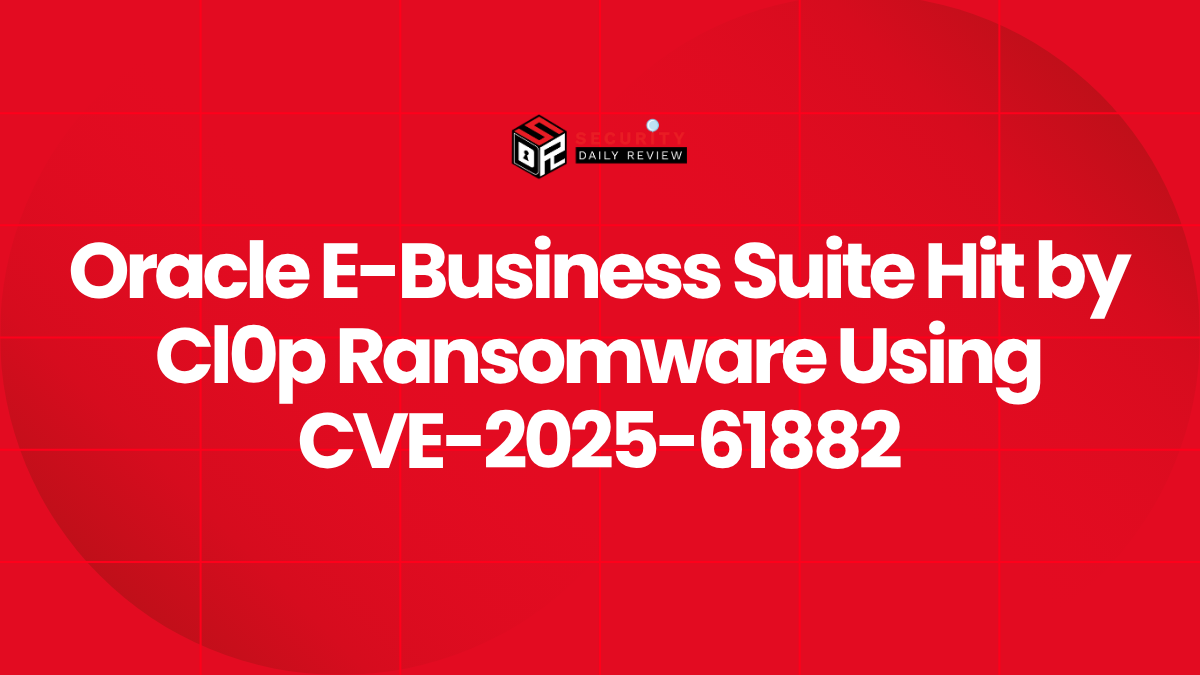A zero-day vulnerability in Oracle E-Business Suite has become the focal point of a widespread and aggressive exploitation campaign led by the Cl0p ransomware group. The flaw—tracked as CVE-2025-61882—resides in the Business Intelligence (BI) Publisher Integration component and allows unauthenticated remote code execution (RCE). Since early August 2025, Cl0p has leveraged this vulnerability in targeted attacks against organizations running vulnerable versions of the widely deployed enterprise application.
Cl0p Ransomware is Exploiting CVE-2025-61882 for Unauthenticated Remote Code Execution
Oracle E-Business Suite versions 12.2.3 through 12.2.14 are affected by CVE-2025-61882, a critical vulnerability that has proven a high-value target for threat actors. Security researchers from Mandiant, Google Cloud’s Threat Intelligence Group, and various national cybersecurity authorities confirm active exploitation that has resulted in data exfiltration, compromise of enterprise workflows, and extortion attempts via ransomware scenarios.
Vulnerability Gives Cl0p System-Level Access Without Authentication
According to Oracle’s official advisory released on October 4, 2025, the core of the issue lies in unauthenticated RCE via the BI Publisher Integration component. The attack can be executed remotely over HTTP, requiring no prior authentication—making internet-facing Oracle E-Business Suite (EBS) instances particularly vulnerable.
Fortinet and Quorum Cyber note that upon successful exploitation, attackers gain control over Oracle’s Concurrent Processing subsystem. This enables lateral movement within enterprise networks, data harvesting, and potential deployment of multiple types of post-compromise implants.
The exploitation chain combines:
- Server-side request forgery (SSRF)
- Carriage return line feed (CRLF) injection
- Authentication bypass
- XSL template injection
These exploit paths collectively allow Cl0p to inject arbitrary code, establish persistence, and launch sophisticated operations against compromised environments.
Cl0p is Shifting from Ransomware Deployment to Data Extortion
Traditionally known for encrypting victim data and demanding ransom for decryption keys, the Cl0p ransomware group has adapted its strategy in recent months. As observed in this campaign, the group now focuses on stealing data and issuing direct extortion threats.
Since August 9, 2025, Cl0p has:
- Conducted mass scanning of internet-facing Oracle EBS servers
- Deployed multi-stage Java-based implants to establish control
- Sent extortion emails to victim executives from September 29 onward, claiming possession of stolen business-critical data
Google’s Threat Intelligence Group confirmed Cl0p’s use of a sophisticated attack framework tailored for Oracle EBS environments. The evolution from encryption-centric ransomware to pure data theft and pressure tactics reflects a broader industry trend in monetizing access to sensitive enterprise systems.
Oracle and Cybersecurity Agencies Urge Immediate Remediation
Oracle’s emergency patch, released alongside its October 2025 advisory, aims to eradicate the immediate threat posed by CVE-2025-61882. However, applying this update can only proceed if organizations have already implemented the October 2023 Critical Patch Update (CPU), a prerequisite for the latest fix.
Oracle’s advisory includes crucial artifacts to assist in detection and response:
- Known malicious IP addresses used by Cl0p during exploitation
- Observed exploitation commands and traffic patterns
- Indicators of compromise (IOCs) for alert tuning and threat hunting
The National Cyber Security Authority (NCSA) and other governmental bodies have explicitly instructed Oracle customers to:
- Immediately apply the emergency patches
- Confirm whether impacted EBS versions (12.2.3–12.2.14) are exposed to the internet
- Monitor logs for anomalous activity linked to known TTPs (tactics, techniques, and procedures) used in the current campaign
Exploitation Timeline and Organizational Exposure
Based on reported timelines from Google, Mandiant, and HIPAA Journal, the attack campaign loosely follows this sequence:
- August 9, 2025 – Initial zero-day exploitation observed in the wild by Cl0p.
- September 29, 2025 – Large-scale extortion campaign initiated, with targeted emails to affected organizations.
- October 4, 2025 – Oracle releases official security alert and patches.
- October 7–10, 2025 – Multiple threat intelligence and national agencies raise global alerts.
Notably, Oracle E-Business Suite is deeply embedded in enterprise operations—managing functions such as finance, HR, procurement, and project management. This ubiquity makes unpatched versions a prime target for adversaries seeking to exfiltrate sensitive data or disrupt transactional workflows.
Key Takeaways for CISOs and SOC Teams
Organizations using Oracle E-Business Suite—especially versions 12.2.3 through 12.2.14—should act without delay. The following steps are considered critical:
- Apply emergency patches immediately: Ensure that the October 2023 Critical Patch Update is in place first.
- Harden and isolate exposed systems: Reduce external accessibility of EBS deployments and segment high-privilege components.
- Implement IOC-driven threat hunting: Scan for known indicators shared in Oracle’s alert and related advisories.
- Review historical logs back to August 2025: Look for Cl0p signatures or evidence of similar exploitation attempts.
This incident underscores the persistent risk posed by unpatched enterprise software and the rising sophistication of groups like Cl0p. For adversaries who can execute remote code without credentials, every delayed patch is a potential breach opportunity.









